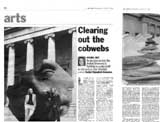| |
|
 |
 |
 |
 |
 |
|
Clearing out the cobwebs
John Russell Taylor on the British Museum’s plan to leap boldly into the 21st Century, and drag all the centuries with it
by John Russell Taylor, The Times, December 5, 2000.
Five years ago, the exhibition Time Machine which shoehorned contemporary art into the Egyptian Galleries of the British Museum, caused a considerable stir: not only did members of the public find, when they gazed into an ancient sarcophagus, that an Andy Goldsworthy assemblage of leaves might be lurking at the bottom, but it looked as if it naturally belonged there.
The show was signposted on the front lawn with a huge bronze face sculpture by Igor Mitoraj, a half-face suggesting the detached head of a monumental sculpted pharaoh lying where it has fallen in the desert sands. Mitoraj was so pleased with the effect that when the exhibition was over he offered to donate the sculpture to the museum.
Since the sculpture would cost about £200,000, you might suppose such a generous gesture would be received with delight. And so it was –in principle. The difficulty was that the British Museum had no machinery for dealing with contemporary art, even as a gift. Which department could be responsible for it? Eventually the curator of Time Machine James Putnam, then of the Egyptian Department, managed to find a way around the bureaucratic restrictions, and the sculpture duly passed into the BM’s possession.
But this pinpointed a problem. Was the museum interested only in the past, seeing no connection between its own collections and the present? Clearly something had to be done if the museum was to be anything but a dusty repository, and to instill the idea that the great relics of ancient civilizations were the products of living, feeling human beings that people of our own time could and should react to and interact with.
The opening up of the Great Court and the Clore Education Centre as the Museum’s millennium project clearly offered the opportunity to do something about it. Putnam was transferred to the Education Department, with charge over a newly created Contemporary Arts and Culture Programme. To signal the new initiative, the Mitoraj sculpture is set to make a return to the front lawn of the reorganized forecourt.
To the skeptical this may all sound dangerously trendy, an attempt by the BM to garner a bit of the publicity attaching to the Tate Modern. But Putnam insists that this is not so. "It is not about acquisitions of contemporary art at all", he maintains. "It is basically about building bridges between the cultures of past and present".
With this in mind, contemporary artists are being recruited to work on specific projects. Already under way is Eternal Artefact ?, which brings the Portuguese artist Joao Penalva into the Conservation Department to observe and document conservation processes as they confront fugitive organic materials. Specifically Penalva is following the conservation of a carved Malangan figure from Papua New Guinea, which has a curious contemporary resonance in that it has been designed and made within the concept of its own obsolescence: the figures are created for a specific ritual purpose, and once the ceremony concerned is over they are simply left to rot. There is therefore a curious inbuilt irony in a contemporary artist being called in to evoke for posterity the spectacle of the Conservation research Laboratory fighting to preserve something which was never meant to be preserved in the first place.
The new exhibition at the BM, Human Image, provides a springboard for the Programme’s next project, which is a one-day conference on January 27 called Human Image Right Now!, which will explore fundamental ideas about the representation of the human image and its links with icons, myths, and identities. One of the speakers at the conference will be the dancer and choreographer Michael Clark, who is also involved in the first of the Programme’s residency projects, which will bring him into the museum to observe human gesture as it is embodied in the museum’s sculpture collections.
Of course, art today is seen as extending far beyond the traditional visual categories, taking in performance, video, installations and, increasingly, sound. The British Museum’s forthcoming centenary exhibition, provisionally called Celebrate Sound, will bring in the New York-based sound artist Bruce Odland to devise a multimedia installation which will reanimate the museum’s unique collection of musical instruments. It has been a feature of Odland’s recent work that computer technology is used to enable visitors to "play" instruments without ever touching the instrument itself, and these interactive techniques will be used to speculate on the sound of instruments from ancient Egypt and Greece.
|
 |
| |
 |
 |
|
|